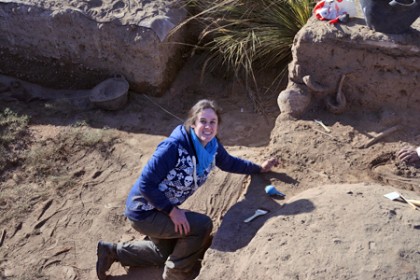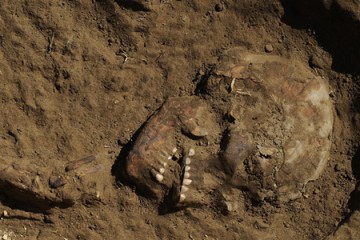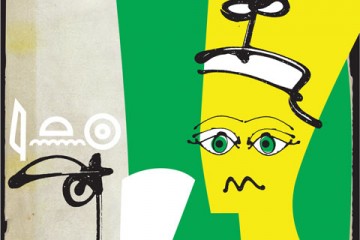A team of Johns Hopkins researchers and students, led by Betsy Bryan, a professor of Egyptian art and archaeology in the university's Department of Near Eastern Studies, has spent the past three weeks conducting field work at the Temple of the Goddess Mut dig site in Luxor, Egypt.

Image credit: Egypt Today
Bryan has been leading Johns Hopkins work teams to Luxor since 1995 and since 2001 has chronicled their expeditions on the Egypt Today blog website. The current team, which includes seven Hopkins graduate students and three undergraduates, has been focusing on the excavation and conservation of an ancient burial site first discovered by Bryan and others in 2012.
We caught up with Bryan via email in Egypt to learn more about her team's current expedition.
What kind of work is the team currently doing at the Temple of Mut site?
This year the team is working behind the Sacred Lake in an area that housed temple dependencies such as the granaries, breweries, bakeries, etc., between around 1600 and 700 B.C. But since 2012 we have found in that same region an earlier "cemetery," which was not expected, because burials generally did not occur on the east side of the Nile where we are and did not take place within sacred precincts. In the period prior to 1600 this was a more domestic environment with houses, etc., and after the temple establishment, the serf and/or captive workers may have been buried here because they were unable to move around elsewhere to choose another spot. This year we are excavating skeletons that we discovered in 2012 but did not have the bioarchaeological expertise to excavate properly. Because we are on the verge of publishing all of our work there since 2001, we are also studying, analyzing, and drawing pottery; registering and drawing small finds; and, of course, photographing everything from the excavation.
Have there been any exciting finds during this or other recent expeditions?
Egypt is always a place of discovery, so we have had no shortage of interesting and even exciting finds. For example, in 2002 and 2003 we found a wonderful life-sized statue of King Ramesses III beneath the floor of the Ramesses III temple at the Mut precinct (there are three main temples in the precinct, and the concession is quite large). We had it reconstructed and it now is in the Luxor Museum, a beautiful and modern museum.
In 2006 we discovered (actually a graduate student overseeing work on the porch of the main Mut Temple discovered) an over-life-sized statue of Queen Tiye, a very famous queen and mother of the heretic King Akhenaten, in nearly pristine condition.
In 2004-2007 we discovered the architectural elements of a "Hall of Drunkenness," where the so-called "Festivals of Drunkenness" were conducted between 1475 and 1460 B.C. Evidence for these festivals had been nearly entirely limited to the Greco-Roman period until our discovery, and it has been covered in several documentaries by Discovery, History, and National Geographic. My own publication of the hall and the ritual as celebrated in the earliest period as at Mut appeared this fall in a scholarly volume.
What sorts of activities are the students involved in at the site? What can they expect to gain from the experience?
The students are rotating through all of our activities if they have not worked with us before (this is true for all the undergrads). They have learned now to identify ceramic fabrics, shapes, and manufacturing techniqes, and they have learned to draw pottery for publication. They have also learned how to do basic surveying using our old-fashioned transit level as well as our brand new Total Station, and they have done both the shooting of points and the holding of the prism or rod used to identify points.
They have also all worked with the bioarchaeologists and osteologists to learn how to carefully excavate skeletons, clean and make them visible for photography, and survey in situ. They have learned basic osteology to identify specific bones (this is especially useful for the two pre-med students with us.)
Posted in Politics+Society
Tagged archaeology, egypt, betsy bryan










